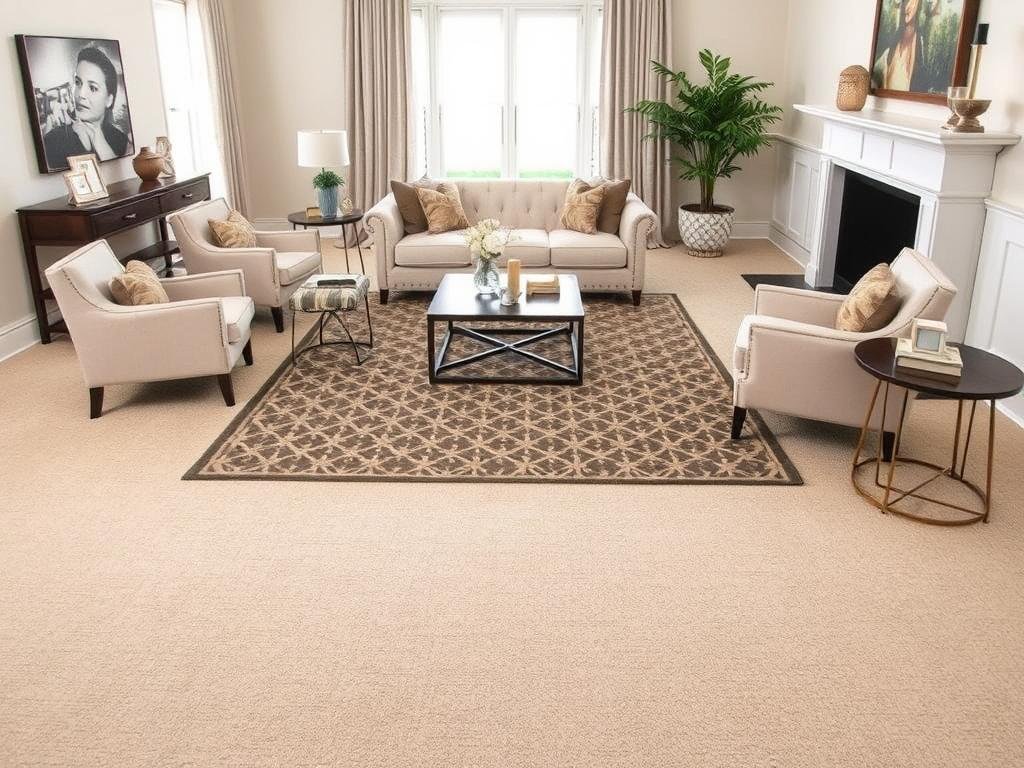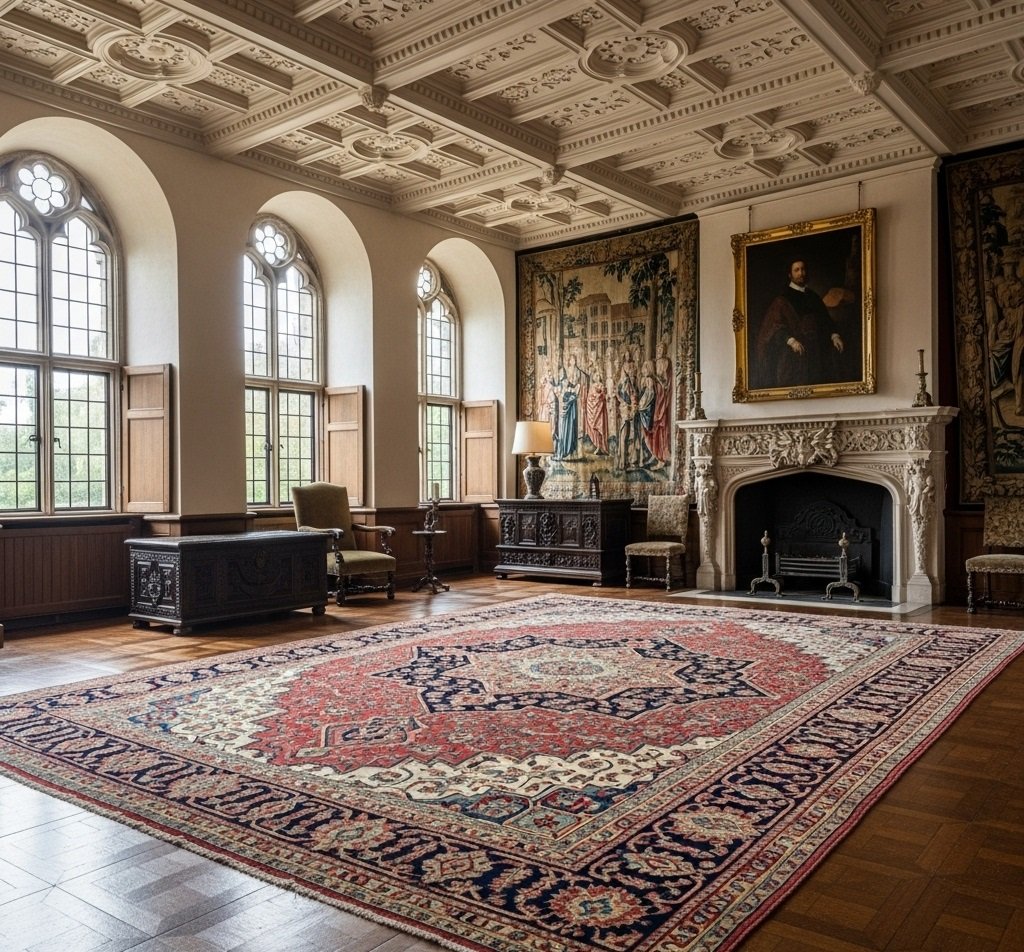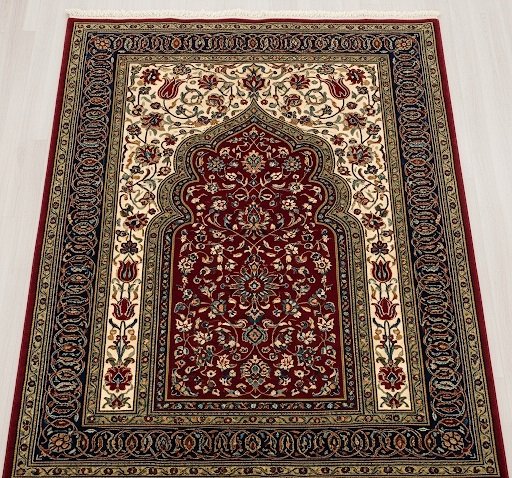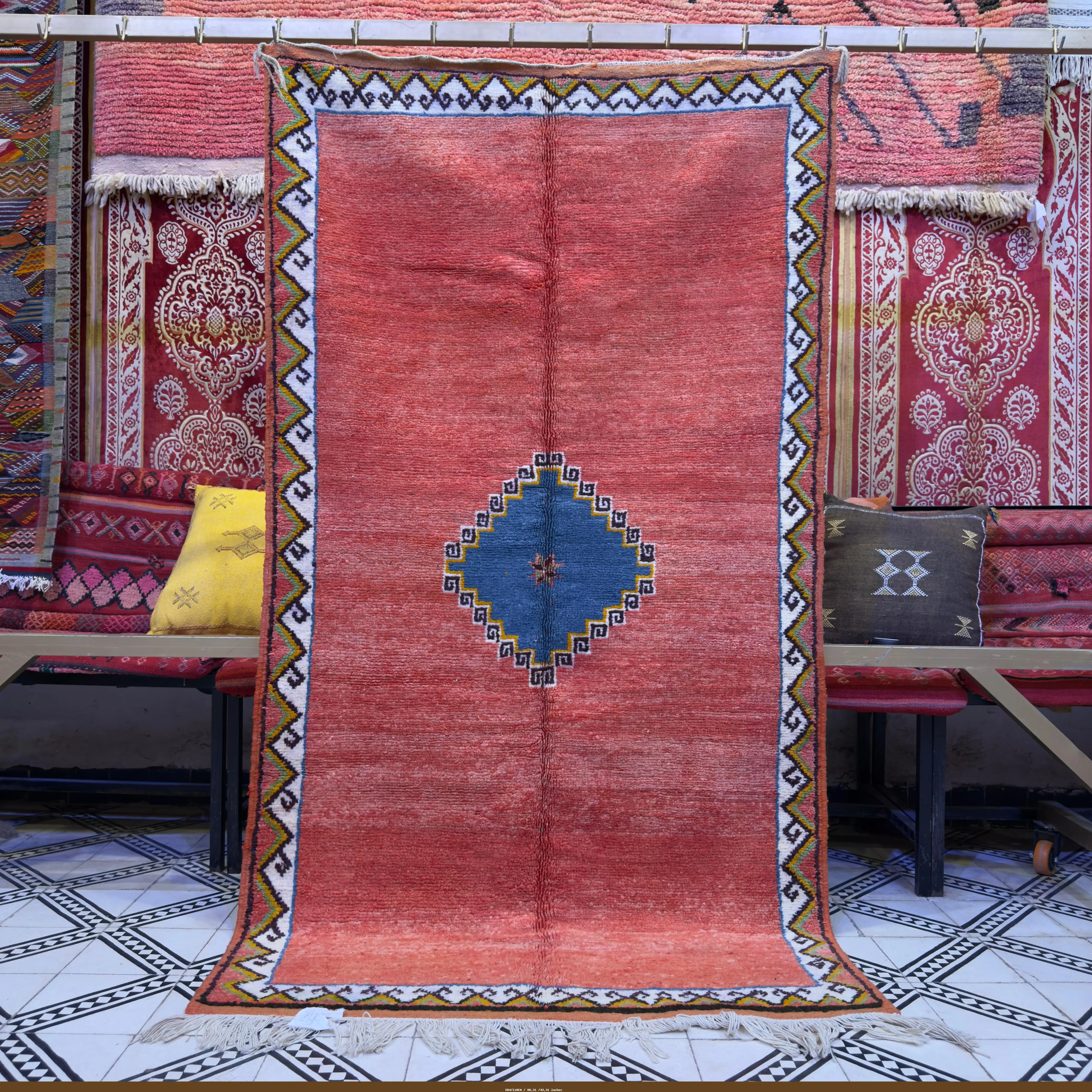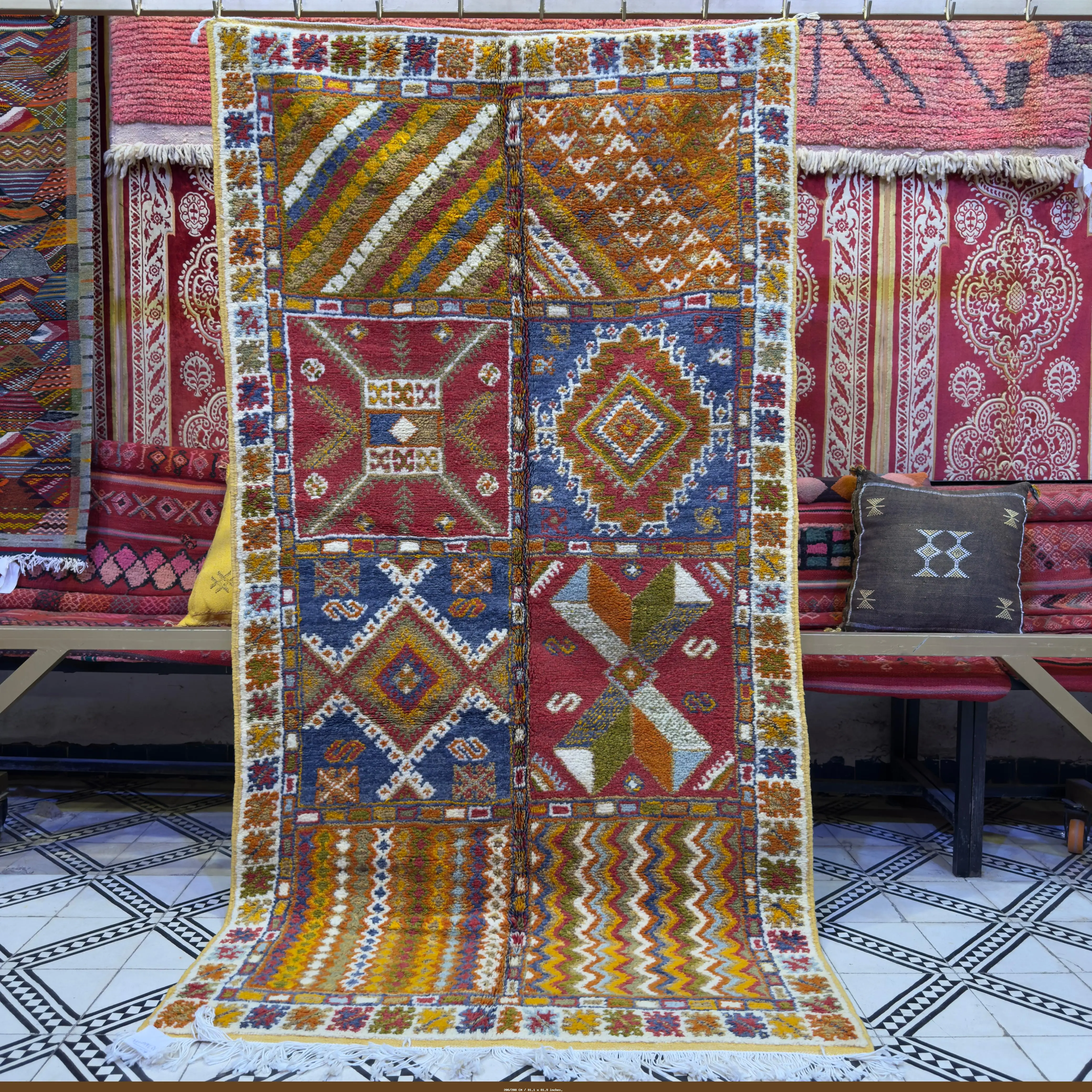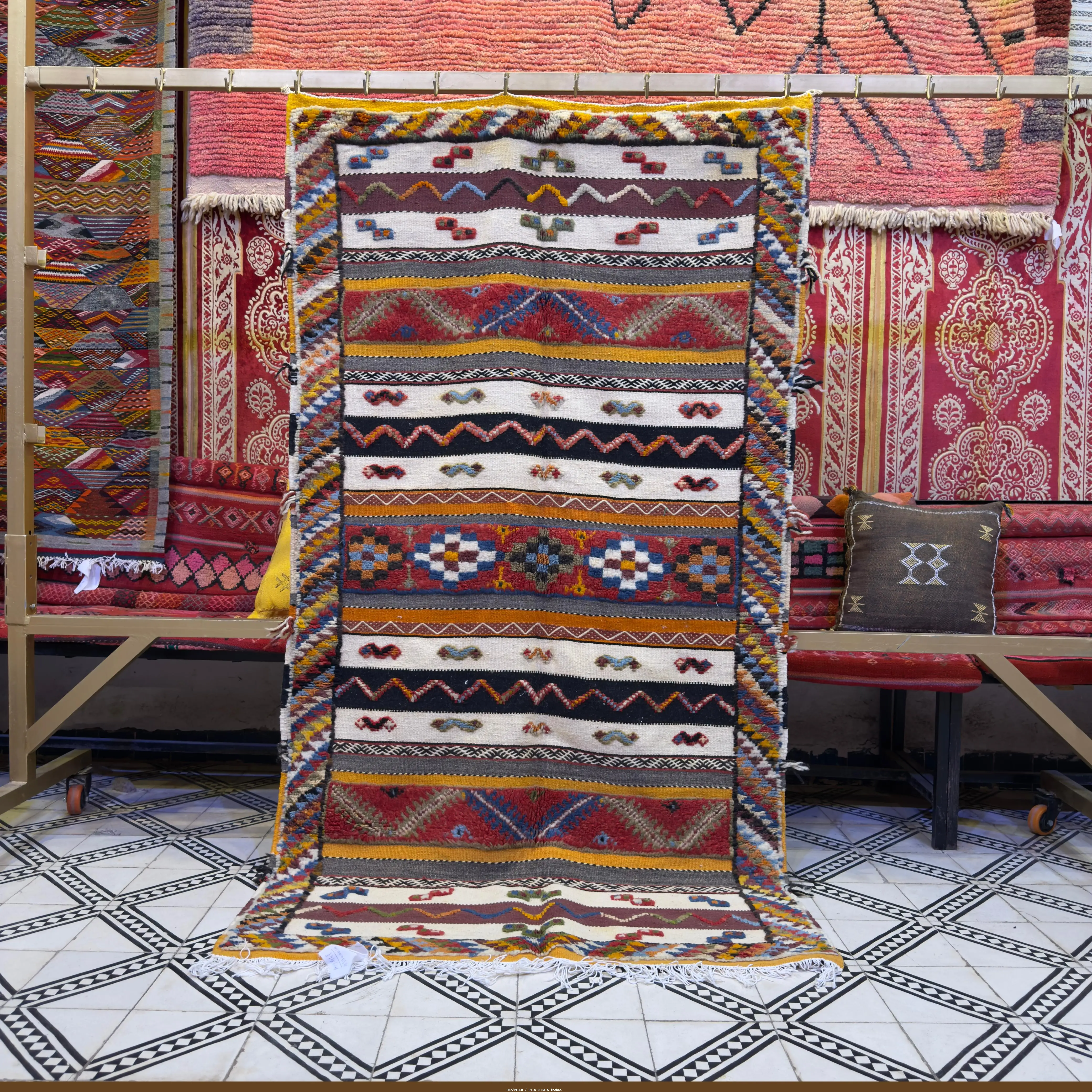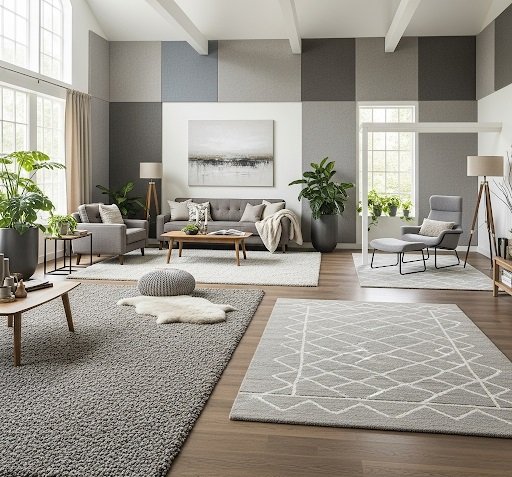
05 Aug 2025
Document Rugs
We put immense effort into making our homes look beautiful. We obsess over paint colors, furniture styles, and lighting. But have you ever walked into a stunning room that just didn't feel right? It might have been cold, loud, or echoey, making conversation difficult and the space feel harsh and unwelcoming. This often-overlooked element is a room's acoustics.
The good news is that one of the most effective tools for perfecting your room's sound is also one of its most beautiful design elements: the area rug. This guide will delve into the science of how a simple rug can dramatically improve your room's acoustics, turning a cavernous, noisy space into a warm, quiet, and inviting sanctuary.
The Science of Sound: Why Your Room Echoes
Sound travels in waves. When you speak, play music, or even walk, these waves radiate outwards from the source. In a room with hard surfaces—like hardwood floors, tile, large windows, and bare walls—these sound waves have nowhere to go but to bounce back. This reflection of sound is what creates reverberation and echo.
A little reverberation can make a space feel live and airy, but too much creates a noisy, chaotic environment. It makes it harder to understand conversations, causes music to sound muddled, and gives the room a cold, impersonal feeling. The solution is not to eliminate sound, but to control it through absorption.

The Rug as a Sound Sponge
This is where the area rug becomes your acoustic superhero. Unlike a hard surface that reflects sound waves, a rug acts like a giant acoustic sponge.
When sound waves hit the soft, porous surface of a rug, they don't just bounce back. Instead, they penetrate the thousands of individual fibers. As the sound energy gets trapped within this dense network of fibers, it is converted into a tiny amount of heat through friction, effectively stopping the sound from reflecting back into the room.
This process of sound absorption has a profound effect:
-
It drastically reduces echo and reverberation.
-
It makes speech clearer and more intelligible.
-
It creates a quieter, more peaceful atmosphere.
-
It gives the room a warmer and more intimate feeling.
How to Choose a Rug for Maximum Acoustic Performance
Not all rugs are created equal when it comes to sound absorption. To get the best acoustic results, you need to consider three key factors: size, material, and thickness.
1. Size Matters Most The more surface area you cover, the more sound you will absorb. A small accent rug will have a negligible effect on a room's acoustics. To make a real difference, you need to think big.
Large area rugs are essential for effective sound control. In a living room, an 8x10 area rug is often the perfect size to cover the main conversational area between your sofa and chairs, absorbing sound right where it's being generated. In a dining room, a large rug under the table will soften the clatter of dishes and cutlery. The principle is simple: more rug equals less echo.
2. Material and Density The material and construction of the rug play a huge role in its ability to absorb sound.
-
Thicker is Better: A thick, dense rug has more fibers to trap sound waves. A high-pile or plush rug will always perform better acoustically than a thin flatweave.
-
Wool is the Champion: Wool is the gold standard for acoustic performance. Its natural, complex, and crimped fiber structure is incredibly effective at trapping and dampening sound energy.
-
Plush Synthetics: High-pile rugs made from soft synthetics like polyester also do an excellent job of absorbing sound and are often a more budget-friendly option.
3. The Unsung Hero: The Rug Pad Never underestimate the power of a good rug pad. A thick, high-quality felt pad placed underneath your area rug adds another substantial layer of sound-absorbing material. It can dramatically boost the acoustic performance of any rug, making even a medium-pile rug perform like a much thicker one.
Conclusion: Designing for Your Ears, Not Just Your Eyes
An area rug is a testament to the idea that great design is about how a space feels, not just how it looks. By choosing the right rug, you can solve acoustic problems, reduce noise, and create an environment that is calm, clear, and comfortable. So, the next time you're designing a room, don't just think about the color and pattern of your rug. Think about the peace and quiet it can bring. By opting for large area rugs made of thick, dense materials, you are making a powerful investment in the sound and soul of your home.
Nous déployons d'immenses efforts pour rendre nos maisons belles. Nous sommes obsédés par les couleurs de peinture, les styles de meubles et l'éclairage. Mais êtes-vous déjà entré dans une pièce magnifique qui ne vous semblait tout simplement pas juste ? Elle était peut-être froide, bruyante ou pleine d'échos, rendant la conversation difficile et l'espace rude et peu accueillant. Cet élément souvent négligé est l'acoustique d'une pièce.
La bonne nouvelle est que l'un des outils les plus efficaces pour parfaire le son de votre pièce est aussi l'un de ses plus beaux éléments de design : le tapis. Ce guide se penchera sur la science de la façon dont un simple tapis peut améliorer considérablement l'acoustique de votre pièce, transformant un espace caverneux et bruyant en un sanctuaire chaleureux, calme et accueillant.
La science du son : Pourquoi votre pièce résonne
Le son se propage par ondes. Lorsque vous parlez, jouez de la musique ou même marchez, ces ondes rayonnent vers l'extérieur depuis la source. Dans une pièce avec des surfaces dures — comme les parquets, le carrelage, les grandes fenêtres et les murs nus — ces ondes sonores n'ont nulle part où aller, si ce n'est rebondir. Cette réflexion du son est ce qui crée la réverbération et l'écho.
Un peu de réverbération peut donner à un espace une sensation de vie et d'aération, mais trop en crée un environnement bruyant et chaotique. Il rend la compréhension des conversations plus difficile, donne à la musique un son confus et confère à la pièce une sensation de froideur et d'impersonnalité. La solution n'est pas d'éliminer le son, mais de le contrôler par l'absorption.

Le tapis comme une éponge sonore
C'est là que le tapis devient votre super-héros acoustique. Contrairement à une surface dure qui réfléchit les ondes sonores, un tapis agit comme une éponge acoustique géante.
Lorsque les ondes sonores heurtent la surface douce et poreuse d'un tapis, elles ne se contentent pas de rebondir. Au lieu de cela, elles pénètrent les milliers de fibres individuelles. L'énergie sonore, piégée dans ce réseau dense de fibres, est convertie en une infime quantité de chaleur par friction, empêchant ainsi le son de se réfléchir dans la pièce.
Ce processus d'absorption acoustique a un effet profond :
-
Il réduit considérablement l'écho et la réverbération.
-
Il rend la parole plus claire et plus intelligible.
-
Il crée une atmosphère plus calme et plus paisible.
-
Il donne à la pièce une sensation plus chaleureuse et plus intime.
Comment choisir un tapis pour une performance acoustique maximale
Tous les tapis ne sont pas égaux en matière d'absorption acoustique. Pour obtenir les meilleurs résultats acoustiques, vous devez prendre en compte trois facteurs clés : la taille, le matériau et l'épaisseur.
1. La taille compte le plus Plus vous couvrez de surface, plus vous absorberez de son. Un petit tapis d'appoint n'aura qu'un effet négligeable sur l'acoustique d'une pièce. Pour faire une réelle différence, il faut voir grand.
Les grands tapis sont essentiels pour un contrôle efficace du son. Dans un salon, un tapis de 8x10 est souvent la taille parfaite pour couvrir la principale zone de conversation entre votre canapé et vos fauteuils, absorbant le son là où il est généré. Dans une salle à manger, un grand tapis sous la table adoucira le cliquetis de la vaisselle et des couverts. Le principe est simple : plus de tapis égale moins d'écho.
2. Matériau et densité Le matériau et la construction du tapis jouent un rôle énorme dans sa capacité à absorber le son.
-
Plus c'est épais, mieux c'est : Un tapis épais et dense a plus de fibres pour piéger les ondes sonores. Un tapis à poils longs ou moelleux sera toujours plus performant sur le plan acoustique qu'un tissage plat fin.
-
La laine est la championne : La laine est la référence en matière de performance acoustique. Sa structure de fibre naturelle, complexe et frisée, est incroyablement efficace pour piéger et amortir l'énergie sonore.
-
Les synthétiques moelleux : Les tapis à poils longs fabriqués à partir de matières synthétiques douces comme le polyester font également un excellent travail d'absorption du son et sont souvent une option plus économique.
3. Le héros méconnu : Le sous-tapis Ne sous-estimez jamais le pouvoir d'un bon sous-tapis. Un sous-tapis en feutre épais et de haute qualité placé sous votre tapis ajoute une autre couche substantielle de matériau insonorisant. Il peut considérablement améliorer la performance acoustique de n'importe quel tapis, faisant même qu'un tapis à poils moyens se comporte comme un tapis beaucoup plus épais.
Conclusion : Concevoir pour vos oreilles, pas seulement pour vos yeux
Un tapis est un témoignage de l'idée que le bon design concerne la sensation d'un espace, pas seulement son apparence. En choisissant le bon tapis, vous pouvez résoudre les problèmes acoustiques, réduire le bruit et créer un environnement calme, clair et confortable. Alors, la prochaine fois que vous concevrez une pièce, ne pensez pas seulement à la couleur et au motif de votre tapis. Pensez à la paix et au calme qu'il peut apporter. En optant pour de grands tapis faits de matériaux épais et denses, vous faites un investissement puissant dans le son et l'âme de votre maison.
Hacemos inmensos esfuerzos para que nuestras casas se vean hermosas. Nos obsesionamos con los colores de la pintura, los estilos de los muebles y la iluminación. Pero, ¿alguna vez ha entrado en una habitación impresionante que simplemente no se sentía bien? Quizás era fría, ruidosa o llena de eco, lo que dificultaba la conversación y hacía que el espacio se sintiera áspero y poco acogedor. Este elemento, a menudo pasado por alto, es la acústica de una habitación.
La buena noticia es que una de las herramientas más eficaces para perfeccionar el sonido de su habitación es también uno de sus elementos de diseño más hermosos: la alfombra. Esta guía profundizará en la ciencia de cómo una simple alfombra puede mejorar drásticamente la acústica de su habitación, transformando un espacio cavernoso y ruidoso en un santuario cálido, tranquilo y acogedor.
La ciencia del sonido: Por qué su habitación resuena
El sonido se propaga en ondas. Cuando habla, pone música o incluso camina, estas ondas irradian hacia afuera desde la fuente. En una habitación con superficies duras —como suelos de madera, baldosas, grandes ventanas y paredes desnudas— estas ondas sonoras no tienen a dónde ir más que a rebotar. Esta reflexión del sonido es lo que crea la reverberación y el eco.
Un poco de reverberación puede dar a un espacio una sensación de vida y amplitud, pero demasiada crea un ambiente ruidoso y caótico. Dificulta la comprensión de las conversaciones, hace que la música suene confusa y le da a la habitación una sensación de frialdad e impersonalidad. La solución no es eliminar el sonido, sino controlarlo mediante la absorción.

La alfombra como una esponja sonora
Aquí es donde la alfombra se convierte en su superhéroe acústico. A diferencia de una superficie dura que refleja las ondas sonoras, una alfombra actúa como una esponja acústica gigante.
Cuando las ondas sonoras golpean la superficie suave y porosa de una alfombra, no solo rebotan. En su lugar, penetran en las miles de fibras individuales. La energía sonora, atrapada dentro de esta densa red de fibras, se convierte en una pequeña cantidad de calor por fricción, impidiendo así que el sonido se refleje de nuevo en la habitación.
Este proceso de absorción acústica tiene un efecto profundo:
-
Reduce considerablemente el eco y la reverberación.
-
Hace que el habla sea más clara e inteligible.
-
Crea una atmósfera más tranquila y pacífica.
-
Le da a la habitación una sensación más cálida e íntima.
Cómo elegir una alfombra para un rendimiento acústico máximo
No todas las alfombras son iguales en lo que respecta a la absorción acústica. Para obtener los mejores resultados acústicos, debe tener en cuenta tres factores clave: el tamaño, el material y el grosor.
1. El tamaño es lo más importante Cuanta más superficie cubra, más sonido absorberá. Una pequeña alfombra decorativa tendrá un efecto insignificante en la acústica de una habitación. Para marcar una diferencia real, hay que pensar en grande.
Las grandes alfombras son esenciales para un control eficaz del sonido. En una sala de estar, una alfombra de 8x10 suele ser el tamaño perfecto para cubrir la principal zona de conversación entre el sofá y los sillones, absorbiendo el sonido justo donde se genera. En un comedor, una alfombra grande debajo de la mesa suavizará el ruido de los platos y cubiertos. El principio es simple: más alfombra equivale a menos eco.
2. Material y densidad El material y la construcción de la alfombra desempeñan un papel muy importante en su capacidad para absorber el sonido.
-
Cuanto más gruesa, mejor: Una alfombra gruesa y densa tiene más fibras para atrapar las ondas sonoras. Una alfombra de pelo largo o afelpada siempre tendrá un mejor rendimiento acústico que una de tejido plano y fino.
-
La lana es la campeona: La lana es el estándar de oro en cuanto a rendimiento acústico. Su estructura de fibra natural, compleja y rizada, es increíblemente eficaz para atrapar y amortiguar la energía sonora.
-
Los sintéticos afelpados: Las alfombras de pelo largo hechas de materiales sintéticos suaves como el poliéster también hacen un excelente trabajo de absorción del sonido y suelen ser una opción más económica.
3. El héroe anónimo: La base de la alfombra Nunca subestime el poder de una buena base de alfombra. Una base de fieltro gruesa y de alta calidad colocada debajo de su alfombra añade otra capa sustancial de material fonoabsorbente. Puede mejorar drásticamente el rendimiento acústico de cualquier alfombra, haciendo que incluso una alfombra de pelo medio se comporte como una mucho más gruesa.
Conclusión: Diseñar para sus oídos, no solo para sus ojos
Una alfombra es un testimonio de la idea de que un buen diseño tiene que ver con la sensación de un espacio, no solo con su apariencia. Al elegir la alfombra adecuada, puede resolver problemas acústicos, reducir el ruido y crear un ambiente tranquilo, claro y cómodo. Así que, la próxima vez que diseñe una habitación, no piense solo en el color y el patrón de su alfombra. Piense en la paz y la tranquilidad que puede aportar. Al optar por grandes alfombras hechas de materiales gruesos y densos, está haciendo una poderosa inversión en el sonido y el alma de su hogar.


